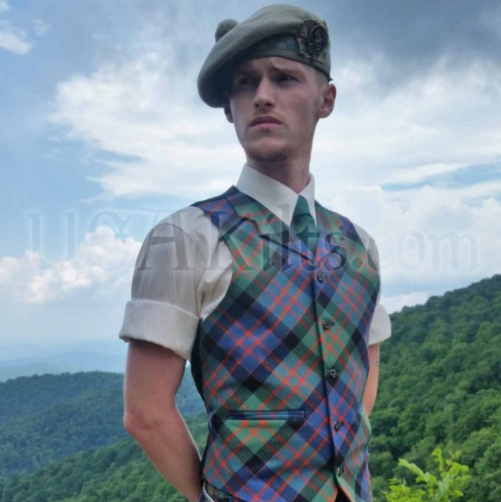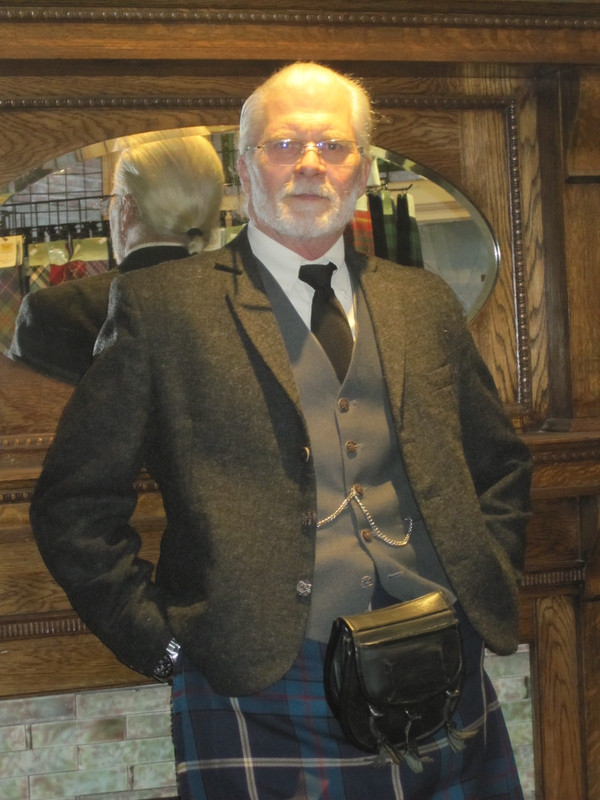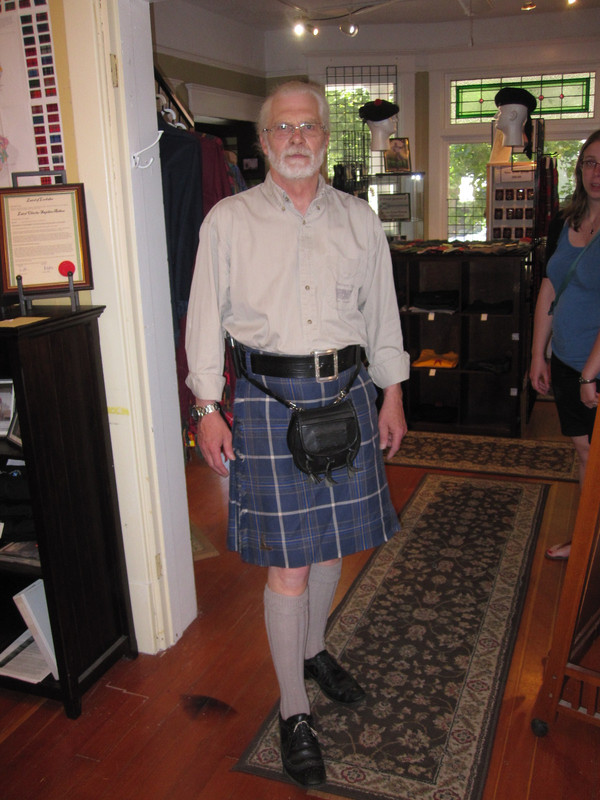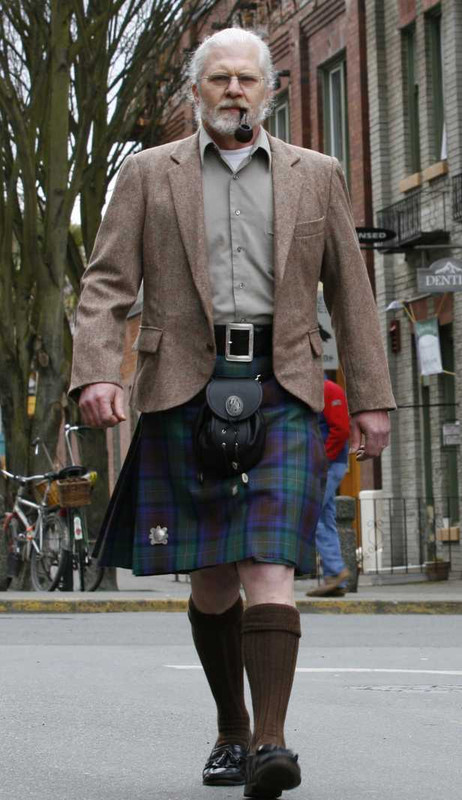|
-
28th October 20, 10:11 AM
#1
Matching everything?
I just purchased a brand new, 100% wool, made in Scotland kilt, vest, belt with buckle, day sporran, and Glengarry at a very attractive price. It had all been ordered some time ago but never worn. (The kilt still has the basting holding the pleats.)
The thing is, that the vest and Glengarry are in tartan that matches the kilt. Is this considered O.K., or perhaps gauche?
Thanks,
jv
-
-
28th October 20, 11:19 AM
#2
 Originally Posted by jviss

I just purchased a brand new, 100% wool, made in Scotland kilt, vest, belt with buckle, day sporran, and Glengarry at a very attractive price. It had all been ordered some time ago but never worn. (The kilt still has the basting holding the pleats.)
The thing is, that the vest and Glengarry are in tartan that matches the kilt. Is this considered O.K., or perhaps gauche?
Thanks,
jv
I'm a fan of matching tartan waistcoats with kilts (if appropriate for the occasion, and especially if the tartan is to the bias!), but I think I'd forego the tartan Glengarry and get a solid colored Balmoral bonnet. Unless they're in pipe bands, most civilians tend to wear Balmorals rather than Glengarrys.
Remember that you don't need to wear the belt if your wearing your waistcoat — it's less than desirable to have your belt buckle peeking out under your waistcoat!
Post a photo of yourself in your Highland attire!
Cheers,
SM
P.S. Here's a photo of a bias cut waistcoat from the USA Kilts website:

Last edited by ShaunMaxwell; 28th October 20 at 12:19 PM.
Shaun Maxwell
Vice President & Texas Commissioner
Clan Maxwell Society
-
The Following 2 Users say 'Aye' to ShaunMaxwell For This Useful Post:
-
28th October 20, 12:01 PM
#3
Thanks for the reply. The vest isn't cut on the bias, but I'm fine with the way it looks.
-
-
28th October 20, 12:28 PM
#4
And I'll offer an opposing view.
I do not wear more than one Tartan item at a time. I do not own and do not wear Tartan vests or waistcoats. I do not own and do not wear a Tartan tie, flashes, or any other item made of Tartan.
Nor do I wear items with clan crests on them other than my X Marks kilt pin on my X Marks Tartan kilt. Like many of my age, and like those within the UK, I try to avoid the "matchy-matchy" look at all cost so do not attempt to match any items of my outfits.
But then, I do not dress in accordance with the rules or conventions of TCHD. (traditional civilian highland dress) My only concern is that I look presentable. I am not trying to impress anyone with how 'Scottish' I am. (I am an American, living in Canada, of Scottish descent on my fathers' side. I do not have or wear a "Clan" Tartan unless you accept that my Clan is the USMC or X Marks.)
I do try to dress neatly, in keeping with the level of formality of the event I am attending.
For those events and places where a jacket and tie are appropriate I may dress like this.

When I am in the kilt shop you will find me dressed like this almost every day.

Going out to dinner with my wife I may add a sport coat cut for a kilt.

As a young man I was taught that understated and simple will always be seen to be in good taste. Understated and simple always show pride and are always classic.
Last edited by Steve Ashton; 28th October 20 at 12:31 PM.
-
The Following 9 Users say 'Aye' to Steve Ashton For This Useful Post:
-
28th October 20, 01:59 PM
#5
Thanks Shaun and Steve,
I can see both points of view, depending on venue or event. Plus, you can only wear what you've got, so there's that. I am trying to assemble a small wardrobe, so I will have options. So far most of what I need for day wear and evening (formal).
This deal was too good to pass up, though; as-new, unused, and the gentleman almost gave it away. The tartan is Campbell of Argyll.
-
-
28th October 20, 03:58 PM
#6
I have a bespoke tartan kilt suit I rarely wear the waistcoat without the jacket but have done it from time to time. I would not have an issue with that for smart day wear. The waistcoat icon the bias. I would however not wear the tartan glengarry, that would to my mind take something from smart to Brigadoon in a very short time indeed.
Waistcoat and kilt, with a different jacket

Full tartan kilt suit

Just the kilt

Waistcoat and kilt without a jacket

-
The Following 5 Users say 'Aye' to McMurdo For This Useful Post:
-
29th October 20, 07:17 AM
#7
 Originally Posted by jviss

Thanks Shaun and Steve,
I can see both points of view, depending on venue or event. Plus, you can only wear what you've got, so there's that. I am trying to assemble a small wardrobe, so I will have options. So far most of what I need for day wear and evening (formal).
This deal was too good to pass up, though; as-new, unused, and the gentleman almost gave it away. The tartan is Campbell of Argyll.
You are quite at liberty to wear more or less what you wish , but if it helps you in any way, tartan waistcoats and tartan jackets worn with the kilt are rarely seen in Scotland during the day and are best avoided. They exist and are sometimes worn here during the day by a very very few with likely, more money than sense. Which actually does not go down well with the locals as they tend to consider it as brash. When we get to evening attire, particularly for the uncommon "white tie" events then they are more common, particularly in the Western Highlands.
We tend to consider tartan waist coats and jackets worn in the day as rather unnecessary and if worn at all, are more in the province of the Clan Chief at a Clan Gathering, or a pop star. I am sorry to say this, but we over here, perhaps unfairly, tend to regard the addition of tartan waist coats and jackets worn for day attire and minor formal evening events, as some North Americans trying to be more Scottish than the Scottish. Sorry chaps, but that is a very common point of view here.
Just saying. 
Last edited by Jock Scot; 29th October 20 at 07:28 AM.
" Rules are for the guidance of wise men and the adherence of idle minds and minor tyrants". Field Marshal Lord Slim.
-
The Following 2 Users say 'Aye' to Jock Scot For This Useful Post:
-
29th October 20, 08:48 AM
#8
My short answer would be:
Matching tartan vest/waistcoat: fine.
Matching tartan bonnet: too touristy.
My long answer would be:
There's a modern attitude I've often encountered, told me by an older Scot 45 years ago as
"no tartan above the waist".
Of course this is simplistic. It's intended, I think, to refer to tartan hats, neckies, shirts, waistcoats, and jackets.
The obvious exceptions would be plaids, civilian day plaids and civilian evening plaids and the plaids pipers wear with "No1 Dress".
However taking the longer view, tartan jackets and waistcoats have always been worn, from some of our earliest images of men in Highland Dress to today.
They were very popular in the 18th century and early 19th century but their popularity began declining around c1840. They never totally went out of fashion, though it's true that tartan waistcoats have been seen more often than entire tartan suits with matching kilts, jackets, and waistcoats.
What was very popular in Victorian times, and having something of a resurgence today, were tweed suits with matching kilts, jackets, and waistcoats.
Bonnets didn't ever seem to participate in the matching thing.
In any case I wouldn't hesitate to wear the matching kilt and waistcoat with any sort of kilt jacket, be it tweed or black.
1860s: matching tartan waistcoat, kilt, and plaid, brown tweed jacket, contrasting tartan hose.

The Duke of Rothesay in matching tartan waistcoat and kilt, with charcoal tweed jacket.

Last edited by OC Richard; 29th October 20 at 08:53 AM.
Proud Mountaineer from the Highlands of West Virginia; son of the Revolution and Civil War; first Europeans on the Guyandotte
-
The Following 3 Users say 'Aye' to OC Richard For This Useful Post:
-
30th October 20, 03:21 AM
#9
 Originally Posted by OC Richard

.............................
The Duke of Rothesay in matching tartan waistcoat and kilt, with charcoal tweed jacket.

I Have not seen the Duke Rothesay wear that waistcoat very often with his day attire and certainly not recently. I wonder why?
You make my point for me OCR, that the tartan waistcoat worn with day kilt attire are "the province" of the very occasional "Clan Chief and pop stars" and I think The Duke would qualify too, don't you?
I know many in North America may find this hard to stomach, but over here in Scotland, particularly in the Highlands of Scotland conservative dressing is the preferred and most common way of thinking for kilted gentlemen during the day, even these days. To put it another way, there is a point with our kilt attire, where we would just not pass. History may point otherwise, the future may go another way, but the recent past and the present say different, for the majority of kilt daywear in Scotland.
Last edited by Jock Scot; 30th October 20 at 03:37 AM.
" Rules are for the guidance of wise men and the adherence of idle minds and minor tyrants". Field Marshal Lord Slim.
-
-
30th October 20, 03:33 AM
#10
After the purchase of my first bespoke kilt about 18 months ago I received a gift from a family member which included.... matching tartan tie, sock flashes and pocket square!
I have worn the tie and pocket square with suits and blazers but never with kilt and even then the tartan tie and square at different times. (Matching tie with pocket square is a definite
NO!)
If wearing tartan then only one item but that's just my personal view.
-
 Posting Permissions
Posting Permissions
- You may not post new threads
- You may not post replies
- You may not post attachments
- You may not edit your posts
-
Forum Rules
|
|
































Bookmarks